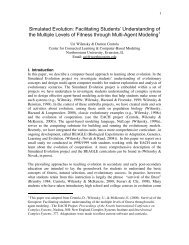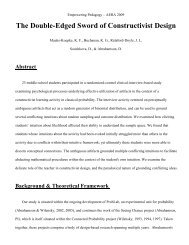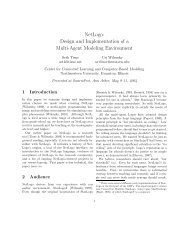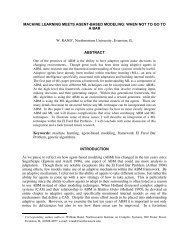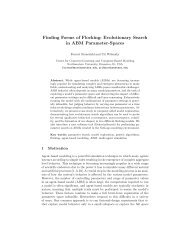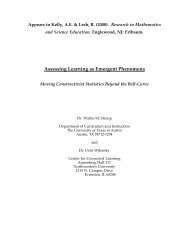Design Guidelines for Agent Based Model Visualization
Design Guidelines for Agent Based Model Visualization
Design Guidelines for Agent Based Model Visualization
You also want an ePaper? Increase the reach of your titles
YUMPU automatically turns print PDFs into web optimized ePapers that Google loves.
<strong>Design</strong> <strong>Guidelines</strong> <strong>for</strong> <strong>Agent</strong> <strong>Based</strong> <strong>Model</strong> <strong>Visualization</strong><br />
10.4<br />
10.5<br />
10.6<br />
10.7<br />
10.8<br />
accomplish the task pre-attentively. For example, the visualization's author can select color or size to<br />
per<strong>for</strong>m pre-attentive visual tasks, shown in Figure 11, such as target detection, boundary detection,<br />
region tracking, counting and estimation (Healey 2006).<br />
Pinpointing the task depends on the phenomena the modeler wishes the viewer to focus on. These<br />
phenomena can be either macro- or micro-behaviors of the model. Perceiving macro-behavior<br />
involves tasks such as boundary detection or region tracking. Both of these tasks assist the viewer in<br />
discerning and tracking clusters of agents. Macro-behavior perception can be supported by other<br />
visual tasks as well, such as estimation, which facilitates the approximation of the quantity of agents<br />
sharing a visual feature (independent of their position and quantity).<br />
Perceiving micro-behavior involves tasks such as target detection, where the user must focus on the<br />
behavior of a single agent amongst all the agents. Tracking a single agent can be quite a challenge in<br />
a flock of agents where the user is distracted by the movement and direction changes of other agents.<br />
Disease Solo <strong>Model</strong><br />
Target detection task<br />
http://jasss.soc.surrey.ac.uk/12/2/1.html<br />
Segregation <strong>Model</strong><br />
Boundary detection task<br />
Radioactive Decay <strong>Model</strong><br />
Estimation and counting<br />
Figure 11. Examples of target detection, boundary detection, and counting & estimation tasks in<br />
NetLogo <strong>Model</strong>s. The Disease Solo <strong>Model</strong> (Wilensky 2005) is at<br />
http://ccl.northwestern.edu/netlogo/models/DiseaseSolo. The Segregation <strong>Model</strong> (Wilensky 1998g) is<br />
at http://ccl.northwestern.edu/netlogo/models/Segregation. The Radioactive Decay <strong>Model</strong> (Wilensky<br />
1998h) is at http://ccl.northwestern.edu/netlogo/models/Decay<br />
Pre-attentive perception demands different design priorities in dynamic animations than in static<br />
images. For example, in static images, feature comparison takes place in space, thus spatial resolution<br />
plays an important role. However in dynamic animations feature comparison takes place in time.<br />
Thus, the temporal resolution is more important than the spatial resolution, since the changes in time<br />
are crucial to studying behavior. So high spatial resolution, which is helpful in static images in order<br />
to provide a large in<strong>for</strong>mation density, should usually be avoided in dynamic visualizations in order to<br />
facilitate a rapid cognition <strong>for</strong> each frame of the animation.<br />
Once the modeler has pinpointed the task necessary to highlight a specific phenomenon, he can begin<br />
by ensuring there is no visual interference confusing the user. If visual interference exists, he should<br />
change or remove the visual variables causing the visual interference. In the next section we will<br />
discuss some examples of visual interference in ABM visualizations.<br />
Visual interference<br />
Visual interference, as described by Callaghan (1989), takes place when a pre-attentive task is<br />
11/20/09 3:30 PM<br />
Page 19 of 32







